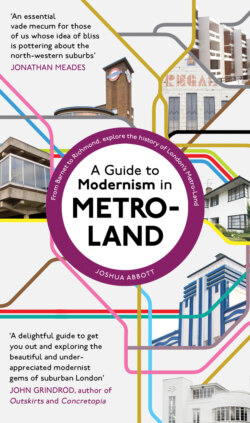Читать книгу A Guide to Modernism in Metro-Land - Joshua Abbott - Страница 5
На сайте Литреса книга снята с продажи.
Author’s Note
ОглавлениеThis section is intended for me to explain the various choices I have made in creating the guide: the area covered, the buildings included and the arrangement of the guide. All of these choices will no doubt elicit questions, and hopefully the following will go some way to answering them
As mentioned in ‘Metro-Land and Modernism’, Metro-Land is of course an idea rather than a place, and different people will sketch different borders for this imaginary county. For this guide I have decided to draw the borders using the county of Middlesex between 1930 and its abolition in 1965. This area includes the ‘original’ Metro-Land (areas like Wembley, Harrow and Pinner) as well as what I think of as ‘greater’ Metro-Land (Barnet, Hounslow, Richmond, etc.). It also allows the guide to be neatly divided into the London boroughs that replaced Middlesex in 1965. Of course, Metro-Land’s elastic borders did stretch into Hertfordshire and Buckinghamshire, so I have included the parts of those counties I feel were affected by the Metropolitan Railway’s expansion in the early twentieth century.
I have been exploring the modernist buildings of Metro-Land since 2011, when I began photographing them as part of a university photography project; later on it became a website. I wanted to choose a selection of these for the guide, to show the reader what I thought was most worth seeking out in each area. This selection consists of well-known buildings that are the best examples of modernism from their time (such as Highpoint), lesser-known buildings that deserve to seen (Kingsley Court) or buildings that help explain how the suburbs grew in the first half of the twentieth century (Sudbury Town tube station). Of course buildings will be left out that readers will feel should have been included, but a guidebook must select some and discard others.
The other two factors in terms of choosing which buildings to feature are chronological and stylistic. There was no ‘big bang’ moment in terms of modernism arriving in Britain; buildings gradually appeared here and there with modernistic elements from the late nineteenth century, but the 1930s was when this trickle became a stream. The earliest building in the book dates from 1912 and the latest from 1990, eighty years of architectural fashion swinging one way and another. In terms of style, the buildings I have included run a gamut of appearances and intentions, from art deco and the International Style to brutalism and high tech. I have even included a few buildings designed in a quite non-modernist way, such as the remarkable housing designed by Ernest Trobridge in Brent between the wars, not modernist but certainly metro-land.
Lastly, a word on the arrangement of the guide. I have arranged the buildings according to what London borough or county they are in, which seems a straightforward choice. Within each area section I have arranged the buildings in chronological order. This is a less straightforward choice, buildings in guides normally being arranged geographically. I have done this for two reasons. First, this is supposed to be a practical book to use while exploring the suburbs, and I want the reader to plan their own routes rather than follow mine, selecting which buildings they want to see. In addition, arranging the buildings chronologically allows the reader to see the way the modernist buildings have changed form and purpose from the start of the twentieth century to its close.
I have given the name of each building as they were originally built, so for example the Empire Pool rather than Wembley Arena. I did this firstly to show the original function of the building, and secondly because the names of buildings are liable to change and so the original name keeps a fixed identity. Also included in the information is the postcode for each building and the nearest tube or rail station to each building. The photographs I have included of the buildings have been taken over the last eight years. This means there may be some discrepancies between the appearance of a building in the book and how it looks when you visit it. Just as with a name, a building’s appearance can fluctuate somewhat.
As this is a guide designed to allow people to see the best modernist buildings in the suburbs, I have not included buildings that cannot be viewed from the street. As such, notable designs such as Shrubs Wood in Buckinghamshire by Mendelsohn and Chermayeff are not included. In the same spirit I have not included buildings that are currently in the process of demolition or redevelopment, for instance the Grahame Park Estate in Barnet.
There may be some who will disagree with the choices I have made and explained here, but they were mine to make, and I hope that the selections I have made will help the reader to discover the wonderful variety of modernist buildings in Metro-Land.
